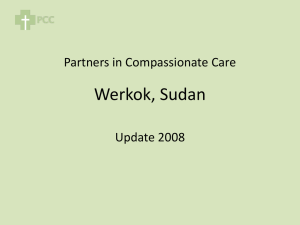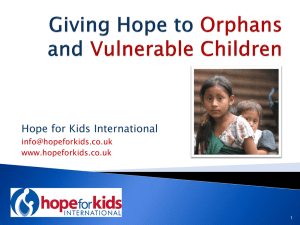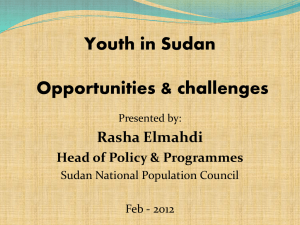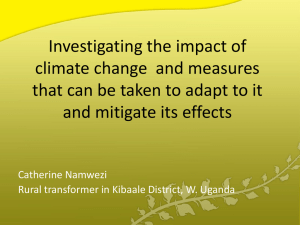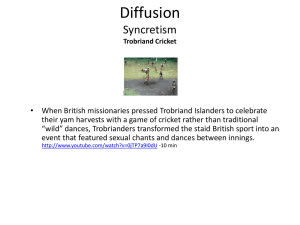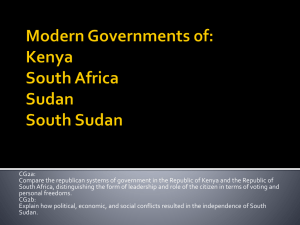LAND USE SYSTEMS IN SOUTH SUDAN AND THEIR IMPACTS
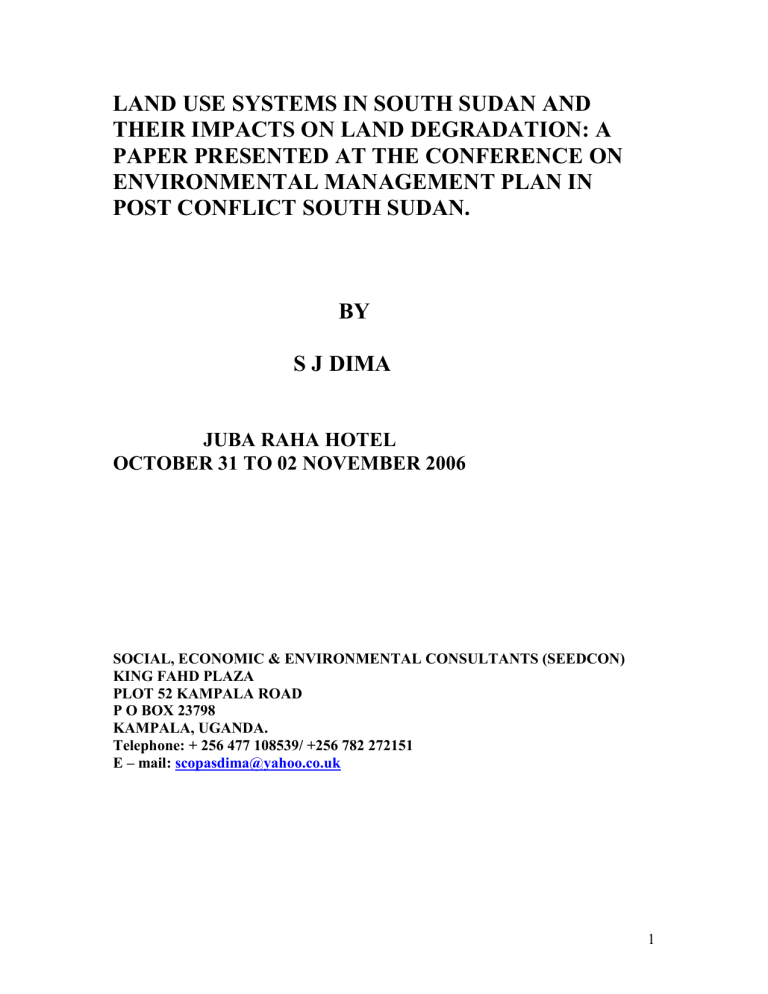
LAND USE SYSTEMS IN SOUTH SUDAN AND
THEIR IMPACTS ON LAND DEGRADATION: A
PAPER PRESENTED AT THE CONFERENCE ON
ENVIRONMENTAL MANAGEMENT PLAN IN
POST CONFLICT SOUTH SUDAN.
BY
S J DIMA
JUBA RAHA HOTEL
OCTOBER 31 TO 02 NOVEMBER 2006
SOCIAL, ECONOMIC & ENVIRONMENTAL CONSULTANTS (SEEDCON)
KING FAHD PLAZA
PLOT 52 KAMPALA ROAD
P O BOX 23798
KAMPALA, UGANDA.
Telephone: + 256 477 108539/ +256 782 272151
E – mail: scopasdima@yahoo.co.uk
1
LAND USE SYSTEMS IN SOUTH SUDAN AND
THEIR IMPACTS ON LAND DEGRADATION:
1.
INTRODUCTION:
Land use systems are the systems human beings have evolved over time for the exploitation of the land resources in their environment. This paper attempts to explore the systems that the people in the territory of
South Sudan have evolved over the last few centuries for the use of the land resources for their survival. The paper then examines the role of each of the land use systems have had on land degradation, together with present and future impacts of land deterioration on the economic development of South Sudan. The paper uses materials from studies on the impacts of land degradation in the African continent to expose the likely consequences of present land use activities on the land specifically and the environment of South
Sudan as a whole. The paper then concludes with the lessons that South Sudan should learn from the experiences of other African countries and offers recommendations to the GoSS authorities on research that should be undertaken to provide solutions to the apparent negative impacts of the present land use systems on the land and the environment in South
Sudan.
2
2.
THE NATURAL ENVIRONMENT OF SOUTH
SUDAN:
South Sudan can be divided into three broad regions.
These are: - o The central Rain lands o The Floodplain; and o The Equatoria region
The Equatoria region in turn is subdivided into five ecological zones, namely: -
The ironstone plateau;
The central hills;
The Green belt;
The mountain slopes and hills; and
The South Eastern plains.
These features are shown in figure 1. Figure 2 shows the agricultural development districts as delineated by the Southern Investigation Team of 1954.
3.
MAIN LAND USE SYSTEMS: a) Crop Farming:
Three different systems of crop farming can be identified. These are traditional systems of cultivation, mechanical aided farming and Intensive farming techniques. Under the traditional systems,
3
the land is brought under production through slash and burn, the so-called shifting cultivation
(De Schlippe, 1954, JRJ Rowland, 1993. and Kevin
M Cleave et al, 1994). This system is very complex in terms of the sequence of operations after a crop or crops have been planted at the same time, weeding – the sequence and times a crop is weeded and harvesting patterns; the number of crops planted on one piece of land at the beginning of and during the season as well as the order in which crops follow each other in a seeming rotation.
Shifting cultivation is ideal under low population growth rate, abundant land, limited capital and technical know-how. The ecological and economic systems were in equilibrium. The mobility of operators to new sites after five to eight years of farming on the same land maintained the stability.
This was augmented by low population growth rates and the traditional extensive agricultural production system associated with shifting cultivation. As populations increased, the fallow periods became shorter and the cropping became more or less permanent. This situation warranted soil conservation, fertility management, plus various forms of agro-forestry activities and the integration of livestock into the farming system. This is the situation pertaining in the Eastern Africa highlands,
Rwanda and Nigeria.
4
In the South Sudan, the pioneering study by De
Schlippe amongst the Azande in Western Equatoria in the early 1950s revealed that although often the crop sequence and stand in a smallholder’s compound appear confused, there was a scientific and systematic order in which the crop operations were carried out. Studies on intercropping systems have indicated that it is a better system of utilizing the soil nutrients and it is this that has given credence to the present adoption of modern organic farming, which has direct links with the African traditional system of agricultural production.
Mechanical cultivation entails the use of machines to undertake agricultural activities. These include the use of oxen drawn implements for carrying out some of the farm operations, use of light tractors for some selected farm operations on government as well as on private farms. These two sub-systems have both advantages and disadvantages. The main advantage is that large areas of land can be brought under production within a short time, while the main disadvantage being that in any mechanical cultivation, both the oxen/tractors and the implements tend to compact the soil and destroy the natural structures of the soils, thus resulting in poor soil drainage and movement of microbial organizations within the soil profiles. These affect plants establishment, growth and eventual yield of the crop. Another disadvantage of mechanical cultivation is that if ploughing along the contours is
5
not adhered to, the furrows made by the tractor wheels create erosion channels, which can eventually develop into gullies especially in terrains with steep slopes.
Under intensive agricultural land and the other environmental resources are intensively used to produce high crop yields as well as rapid weight gains in livestock, poultry and other animal breeds.
This demands intensive use of natural manure, fertilizers and growth hormones as well as efficient and effective scientific management to ensure that the quality and the fertility of the land is maintained and sustained. The land is farmed continuously with the aid of fertilizers to cope up with the level of outputs expected. Too much use of chemicals very results in environmental pollution. For example the soils may become acidic, the runoff from the land carries the residual fertilizers and other chemicals into water bodies, causing problems for the water itself and natural resources such as fish and other aquatic life. Both in urban and in rural areas agricultural chemicals are known for poisoning the water and rendering unsuitable for humans, livestock and wildlife.
6
b) Livestock Grazing:
Livestock grazing is an important and extensive land use system in South Sudan. This is largely practised in the flood plains in the sudd, but also in the ironstone plateau, the central hills and in the
South Eastern plains. The traditional systems adopted by the people tend to compact the soils and overtime result in some grass and shrub species disappearing from the range. Because of the large herds kept in some of the areas, overgrazing is now visible in some of the areas, especially during the dry season and around watering points along the cattle routes to the toich. The traditional systems of keeping cattle and the lack of demand for consumer goods has been blamed for the low off-take from the South Sudan herd. Cattle are sold in large numbers only when there is drought and the livestock owners do not have sufficient grain.
Besides overgrazing, livestock especially cattle are known for causing soil erosion through their feet dislodging grass stems and roots as they graze on the range. Overtime this results in the loosening of the soil surface and both wind and water erosion set in. c) Forest harvesting and tree planting:
7
Since time immemorial, human beings have been using forests for fuel, food, medicine, building materials and other numerous uses. We have seen that most arable land has been taken from natural forests through the slash and burn system. Cleaver et al (1994), estimate that Sub Saharan Africa’s 679 million hectares of forest in 1980 has been diminishing at the rate of 2.9 million hectares per annum through slash and burn, logging and stabling of large commercial farms. The resulting deforestation has been reflected in half of the farmland having soil degradation and erosion. It is a common knowledge that the radius for collecting firewood and charcoal becomes longer, the bigger the population of the town. This is evident in the town of Juba where we are, but it is also true in the other towns of South Sudan.
In the 1960s and 1970s residents used to harvest thatching grass and building poles on the edge of the town. These days you a truck to move out of juba to be able to get good building poles. The current prices of building poles in Juba, tell this story better! Deforestation has significant negative effects on local and regional rainfall and hydrological systems.
Tree planting is an important land use activity in
South Sudan. But this is limited to fruit trees like mangoes, citrus fruits, guavas and other popular fruit trees than replacing of natural trees cut down
8
for opening the land for agricultural production or for firewood. Some governments have thought establishing forests in the vicinity of towns to ensure the supply of firewood for the urban dwellers, but this is not widespread. d) Buildings and roads construction:
The construction of buildings and roads take sizeable areas of land. In some of the cities in
Africa such as Kampala and Nairobi, buildings and the accompanying compliments of roads network to serve the residents have consumed fertile agricultural and forestry land. The clearing of land for both buildings and roads construction results in the loss of biodiversity of both fauna and flora, through the destruction of unique habitats where the buildings are located or where the roads pass. Often when the land is cleared for buildings, excavations result and if not properly covered, result in land degradation and soil erosion. In the case of roads, channels meant to divert water from the surface of the roads, end up being land degradation sources that result in intensive soil erosion. Right now there is a huge reconstruction programme in South Sudan and these processes are on the increase unless checked. The recently graded Juba Yei road testifies to this.
9
e) Mining and oil drilling activities:
Mining activities the world over are known for leaving large and ugly land surfaces after the mineral being tracked has been exhausted. In recent years companies have been forced to rehabilitate the land by afforestation or establishing aqua fisheries and crocodile farming. A good example is that of the Bamburi Cement Factory near Mombasa in
Kenya, where excavations for the limestone have been rehabilitated to a beautiful nature trail in which there are wildlife, crocodile farms as well as fresh water aqua fisheries. In the South Sudan, the gold mines in Kegulu, Kapoeta and other places as well as the copper mines in Hufrat el Nahas in Bahr el
Ghazal are evidences of the scourge of mining on the earth’s surface.
The drilling for oil and other underground minerals is a new land use system in South Sudan. Oil is a dangerous and long-term pollutant on soils. The experiences of the Ogoni people in the Niger delta in Nigeria with oil spills into the land and water systems tell it all. Available information indicates that soils affected by oil spills may take up to fifty years to regain their natural structures and fertility levels. It is probably the recognition of this that has forced the Ogoni people to battle it out with Shell the polluter! South Sudan needs to use the experiences of other countries to safeguard its
10
environment while exploiting its oil and other mineral resources.
4.
IMPACTS OF THE LAND USE SYSTEMS ON
THE LAND: a) Land Degradation:
Land degradation can be defined as the deterioration of the quality of land because of it being subjected to use and abuse. In other words a degraded land can longer perform its natural responsibilities of supporting life forms such as plants, trees, animals and other fauna to a satisfactory level. A degraded land results in degraded soils, which lose their fertility and water absorption and retention capacity with adverse effects on vegetative growth. This in turn affects animals both herbivores and carnivores. The limited number of studies undertaken in South Sudan indicates that the land use systems have had some negative effects on the quality of land. The study undertaken by De Schlippe amongst the Azande concluded that:
‘To sum up the unexpected changes which due to cultural linkages, took place as a consequence of intentional changes introduced administratively, it must be stated that unfortunately that almost in every case these changes were deleterious and
11
undesirable, the Azande reverted to their traditional farming practices with cotton virtually replaced by rice whose production practices were acquired by the Azande while they were in exile during the war’.
The Azande Scheme as it was called with its headquarters at Nzara Complex was introduced by the Anglo-Egyptian colonial administration with the objective of incorporating cotton as a cash crop amongst the Azande subsistence economy. This was done without a prior base line study to identify the constraints in the household smallholder production system. After four years of production, the quality of land deteriorated drastically. This was reflected in the yields of seed cotton the smallholders were getting which resulted in very low incomes to the producers despite of the fact that cotton took about
75 % of the labour resources of the settled Azande households. It is probably this that made the smallholders to replace cotton with rice, which they could consume at the household level and sell the surplus production in the local market. The same reaction was many years later to be experienced by the management of the Gezira Scheme, thousands of kilometres to the North East of the Azande
Scheme, when the tenants rebelled against the continued production of cotton as the dominant crop in light of falling yields and world prices, preferring to produce rice and lubia which had better yields and prices in the local market.
12
In the 1970s and 1980s the Project Development
Unit, a World Bank funded project for which the writer worked for almost ten years, undertook a number of studies in South Sudan- baseline socioeconomic surveys, crop trials, sociological studies and exploratory soil surveys in six development districts. These were Aweil, Gogrial, Mundri,
Rumbek, Wau and Yei. The soil survey reports indicate that in almost all the districts, some of the soils have been degraded and become infertile with reduced ability to support either crop production or livestock grazing. This situation is unlikely to have changed for the better in the intervening years when the war intensified in South Sudan. The situation in the rest of the development districts in South Sudan is likely to be similar except where the inhabitants were forced out as internally displaced or refugees, in which case the land reverted to fallow and should have now regained some of its fertility through natural regeneration.
Amongst the internally displaced within South
Sudan, some communities moved with their animals to other districts or even states. The implication of this is that lands that had been degraded were left to recover under the normal fallow system, while the areas where the communities moved, have been subjected to intensive grazing in the last fifteen to twenty years. Moreover where whole communities move with their livestock, the environment is often
13
destroyed. Trees are cut for building poles for constructing shelters; as they settle down, more trees are cut for firewood and for burning into charcoal for sale to the nearest urban settlement. At the same time the range is overgrazed because the livestock is kept within the environs of the settlement. After three to four months of the new comers settling, the environment is laid bare of trees and grass; the livestock is moved further away into fresh vegetation and the process is repeated. As the land is left bare, trampling by cattle and wild animals result in the loosening of the surface of the soil, exposing it to wind erosion and severe runoff when the rains set in. This process must have taken place in many parts of South Sudan and therefore there is urgent need to assess its impacts on the long development of both the crop and livestock subsectors of South Sudan’s economy. b) Deforestation:
Deforestation is the wide spread destruction of vegetative cover. K M Cleaver et al (1994) assert that deforestation has been responsible for prolonged periods of below average rainfall and the cause of the accumulation of carbon dioxide and nitrous acid (two of the green house gases). The slash and burn system contributes vast quantities of carbon dioxide and other trace gases to the global atmosphere. In South Sudan the annual burning of forest areas to provide early grazing for both
14
livestock and wildlife no doubt releases huge quantities of carbon dioxide into the atmosphere.
The intense heat produced during the burning of dry grass, together with dry leaves and other dead branches not only destroy the humus in the topsoil, but also kill many plants and animals each year.
Immediately after the burning, the baked land surface is fragile and exposes the soil to wind and water erosion. Every year some of the burnt forestland is taken for crop production as human population increases. Large areas of forests wetlands, rivers and valley bottoms have been converted to farmlands in West Africa, Eastern and
Southern Africa because of increasing human population. In the case of Southern Africa, pressure was brought on earlier when white settlers took the best land and the blacks were pushed to the marginal lands. KM Cleaver et al ibid estimate that average per capita arable land in Sub Saharan
Africa declined from 0.5 hectares per person in
1965 to. < 0.3 hectares per person in 1990. Many people are now increasingly compelled to remain on the same parcel of land.
15
c) Degraded Soils:
Soil fertility and soil structure deteriorates quickly when fallow periods are too short. Where population growth rate has been rapid, reduction of arable land per farmer and soil degradation have greatly outpaced the countervailing innovation.
When farming is not viable, people adjust by moving out to establish new farms on virgin land.
The migrants take to the new places their knowledge of farming techniques they practiced in the areas they left and these are often detrimental to the new environment. In most of Africa rapid population growth is pushing settles to extend farming and grazing into areas that are geographically unsuited to these forms of land use.
This situation was witnessed by the writer in
Nanyuki District in Kenya, where farmers who moved out of the Central Province continued to grow maize which is greedy for nutrients and water in an environment which is semi-arid at best and arid at worst. Traditional communities will always do what they are used to and good at wherever they are. This is the situation in South Sudan. Change to the unknown is a risky business and tends to expose families and communities to food insecurity and social disrepute. It is this attitude that has led most
African farmers to be labelled conservative by newcomers to the African farming system.
Traditional farmers need to be assured of the success of new innovations in terms of food security
16
and their status in the society if they are to adopt them. Very often those introducing new innovations do not consider the fact that the new innovations have to compete for the same farm resources that are used for the production of food crops or rearing livestock. d) Deterioration of the natural resources base.
Ecologists expert opinion posit that most of Sub
Saharan Africa’s natural resource base and ecological environment is deteriorating primarily because of the high rate of loss of the vegetative cover, as a result of deforestation and convergence of global and regional climatic changes and deviation from longer- term to shorter –term fallow periods. As has been pointed out earlier in this paper, these conditions do prevail in South Sudan.
Forests are being cleared for farming and trees are logged for firewood and logs for timber. We are all aware of what happened to the high value teak plantations in South Sudan and other hard woods during the war and immediately after the CPA had been signed. The steps that the GoSS Ministry of
Agriculture and Forestry to institute an orderly exploitation of the forestry resources must be commended. A 1980 FAO/UNEP study estimated
17
that 3.7 million hectares of forests were being cleared each year by farmers and loggers (Lanley,
1982). Recent estimates put the figure at 2.9 million hectares, while reforestation in the same period in the 1980s was about 133,000 hectares or about 5 % of deforestation, see table A 19. e) Impacts of deforestation of land on wildlife:
Deforestation of land has severe negative impacts on wildlife habitat and biodiversity and irreversible losses of wild animals and plant life. The intense heat produced during the burning of forests kills hundreds of animals, insects and plants. The IUCN and WRI estimate that 64 % of the original wildlife habitat in SSA has already been lost due to deforestation, conversion of wild lands to agricultural uses and other human activities and excessive harvesting of wildlife, including poaching and illegal trade in endangered species. In the South
Sudan it is a common knowledge amongst those who were in the bushes and forests that wildlife suffered greatly through killing by combatants on both sides. The act of killing of wildlife took many forms, some were killed for food, and others were killed in the battlefields, while others were killed for the value of their trophies or hides and skins.
Like the human beings, many wildlife had to migrate to distant places including neighbouring countries two incidents illustrate vividly the
18
situation that prevailed during the war in South
Sudan. One SAF officer narrated the story that whenever they attacked a forest or an area where they suspected the SPLA were hiding, the amount of firepower they unleashed was expected to achieve 95 % kill of human beings, wildlife, domesticated animals and plant life! My late mother told us of her experience with the execution of the scourge earth policy by the SAF. The village of
Laropi was attacked in the afternoon. The first assault was bombing by the Sudan Air force. This was then followed by the infantry who destroyed any thing they found on their way –human beings, livestock, grain stores as well as growing crops. She and fellow villagers had to run to the nearest stream to hide. The livestock seeing the people running, also starting running with them. Whenever any one of them lay down to hide, the livestock too hid with them! f) Impacts of rangeland degradation on livestock production:
Twenty five million of the world’s forty million nomadic and transhumant pastoralists live in Africa.
The FAO estimated that between 1963 and 1983 the cattle of the pastoralists in the Sudano-Sahelian belt increased by 74 %; those in West Africa by 65 % while those in Southern Africa increased by 61 %.
But the quality of the rangeland has declined
19
because of the movement of cultivators to the best grazing lands and converting them into croplands.
Kenya and Botswana are good examples of this pattern of movements. In the South Sudan the situation appear to be the opposite. In the last three decades the Arab tribes north of the borders of
South Sudan have been pushing southwards in search of grazing pastures and water. At the same time some of the South Sudan communities in the flood plains have been pushing south to the ironstone plateau and the central hills for better grazing and watering facilities. Some of these movements especially those from North Sudan have often ended up in conflicts with the indigenous people resulting in many people being killed.
Increasing cultivation of lands adjacent.
20
5. Conclusions and Recommendations:
From the brief survey of the land use systems in South
Sudan, it can be concluded that there are clear indications that the quality of land has deteriorated in many places.
That with expected increase in population of human beings and animals, the deterioration process of the land and the environment as a whole is likely to become worse. For example in the Central Rain lands and the Flood plains, grazing land and watering facilities nay become battlefields amongst communities and tribes sharing these resources. In the Equatoria Region, particularly in the Ironstone plateau and the Central Hills, soils deterioration is becoming a serious problem in some places as revealed by the exploratory soil survey in a number of development districts undertaken by the PDU in the 1970s and 1980s.
This data together with that from other studies conducted by other development projects such as ILACO in the Penko plains, East of Bor are out of date.
From the data on land degradation in many Sub Saharan
African countries, together with their impacts on the environment and economic activities in those countries, it can be concluded that South Sudan has many lessons to learn to avoid further land degradation, particularly decline in soil fertility.
21
Recommendations:
On the basis of the conclusions reached on the quality of land in South Sudan, as a result of the traditional land use practices, it is recommended that the Ministry of
Environment, Wildlife, Conservation and Tourism
(MEWCT) should put as one of its top priorities a comprehensive research programme on land use systems including. Specifically MEWCT, together with the international community and in collaboration with the
States authorities should undertake the following: -
1.
Urgently undertake a detailed study on the different traditional land use systems to update earlier studies to give a complete picture on the status of the quality of land in South Sudan;
2.
Carry out land use classification studies to delineate appropriate ecological zones together with their most suitable uses, taking into consideration their present uses and the traditional and social sentiments attached to them;
3.
Undertake specific ecological studies on serious degraded land areas with a view to recommend conservation measures to safeguard endangered wildlife species; and
4.
Finally prepare guidelines for the sustainable exploitation of the land resource in South Sudan, under the three broad ecological regions and their environments.
22
References.
1.
JR Anderson. 1994. Food based growth strategies, in Agricultural
Technology. Policy issues for the international community. CAB
International.
2.
Kevin M. Cleaver, R. Gotz, and A Schreiber. 1994. Reversing the spiral. The population, agriculture and environment Nexus in Sub Saharan Africa. The
World Bank.
3.
De Schlippe. 1956. Shifting cultivation in Africa. The Z system of agriculture,
Rouledge and Kegan Paul, London, quoted in S J Dima. 1985. Explorations in
Farm Planning as an aid in rural development planning in Equatoria Region,
Southern Sudan. PhD thesis (unpublished).
4.
Falkoner, Julia 1992. Non timber forest products in Ghana’s forestry zone: issues for forest conservation.”In Cleaver et al 1992. pp 177 – 181.
5.
FAO. 1990 b . The conservation and Rehabilitation of African lands. An international scheme ARC/90/4 FAO Rome.
6.
FAO 1983. Food Aid in figures. FAO Rome.
7.
FAO/UNEP. 1981. Forest resources of tropical Africa. Part 1, Regional synthesis FAO Rome.
8.
Lanley Jean Paul. 1982. Tropical forest resources.FAO forest paper No. 30,
FAO Rome.
9.
JK Lynam and MJ Blackie. 19 . Building effective agricultural research capacity. The African challenge.
10.
Ministry of Agriculture and Natural Resources, PlanningDevelopment. 1982.
Mundri Agricultural District. Exploratory Soil Survey. Report No. 31. Booker
Agriculture International.
11.
Hans Ruthenburg. 1980. Farming systems in the Tropics. Third Edition.
12.
Schramm Gunter and Jeremy Warford. 1989. Environmental management and
Economic Development.
13.
Southern Development Investigation Team. 1954. Natural Resources and
Development Potential in Southern Provinces of the Sudan.
23

